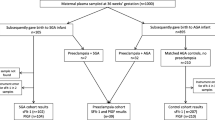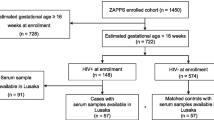Abstract
Purpose
To study the role of the TTR-RBP4-ROH complex components (transthyretin, serum retinol binding protein, retinol) and of angiogenic factors PlGF (placental growth factor) and sFlt-1 (soluble fms-like tyrosine kinase-1) in pregnancies complicated by small for gestational age infants (SGA).
Methods
Case control study conducted on maternal serum collected between 11 + 0 to 13 + 6 weeks of gestation. TTR, RBP4, ROH, PlGF and sFlt-1 were measured in SGA patients (birth weight <10%) who delivered at term (n = 37) and before 37 weeks of gestation (n = 17) and in a matched control group with uneventful pregnancies (n = 37).
Results
We found decreased RBP4 in SGA patients that delivered fetuses <3% and in fetuses delivered after the 37 weeks of gestation compared to controls [1.50 (95% CI 1.40–1.75) vs 1.62 (95% CI 1.47–1.98), p < 0.05]. Further, we found lower PlGF and sFlt-1 concentrations in SGA that delivered before 37 weeks of gestation compared to controls (respectively, PIGF and sFlt-1: 39.7 pg/ml (95% CI 32.3–66.3) vs 62.9 pg/ml (95% CI 45.2–78.4) and 906 pg/ml (95% CI 727–1626) vs 1610 pg/ml (95% CI 1088–212), p < 0.05).
Conclusions
First trimester maternal serum RBP4 and angiogenic factors PlGF and sFlt-1 can differently predict the timing of delivery of pregnancies complicated by SGA fetuses.

Similar content being viewed by others
References
American College of Gynecologists (2013) ACOG Practice bulletin no. 134: fetal growth restriction. Obstet Gynecol 121(5):1122–1133.
Parra-Saavedra M, Crovetto F, Triunfo S, Savchev S, Peguero A, Nadal A, Parra G, Gratacos E, Figueras F (2014) Neurodevelopmental outcomes of near-term small-for-gestational-age infants with and without signs of placental underperfusion. Placenta 35(4):269–274
Visentin S, Londero AP, Grumolato F, Trevisanuto D, Zanardo V, Ambrosini G, Cosmi E (2014) Timing of delivery and neonatal outcomes for small-for-gestational-age fetuses. J Ultrasound Med 33(10):1721–1728
Huppertz B (2008) Placental origins of preeclampsia: challenging the current hypothesis. Hypertension 51(4):970–975
Staff AC, Benton SJ, von Dadelszen P, Roberts JM, Taylor RN, Powers RW, Charnock-Jones DS, Redman CW (2013) Redefining preeclampsia using placenta-derived biomarkers. Hypertension 61(5):932–942
Akolekar R, Syngelaki A, Poon L, Wright D, Nicolaides KH (2013) Competing risks model in early screening for preeclampsia by biophysical and biochemical markers. Fetal Diagn Ther 33(1):8–15
Akolekar R, Syngelaki A, Sarquis R, Zvanca M, Nicolaides KH (2011) Prediction of early, intermediate and late pre-eclampsia from maternal factors, biophysical and biochemical markers at 11–13 weeks. Prenat Diagn 31(1):66–74
Monaco HL (2000) The transthyretin-retinol-binding protein complex. Biochim Biophys Acta 1482(1–2):65–72
Gutierrez-Mazariegos J, Theodosiou M, Campo-Paysaa F, Schubert M (2011) Vitamin A: a multifunctional tool for development. Semin Cell Dev Biol 22(6):603–610.
Yang Q, Graham TE, Mody N, Preitner F, Peroni OD, Zabolotny JM, Kotani K, Quadro L, Kahn BB (2005) Serum retinol binding protein 4 contributes to insulin resistance in obesity and type 2 diabetes. Nature 436(7049):356–362
Henze A, Frey SK, Raila J, Scholze A, Spranger J, Weickert MO, Tepel M, Zidek W, Schweigert FJ (2010) Alterations of retinol-binding protein 4 species in patients with different stages of chronic kidney disease and their relation to lipid parameters. Biochem Biophys Res Commun 393(1):79–83
Vascotto C, Salzano AM, D’Ambrosio C, Fruscalzo A, Marchesoni D, di Loreto C, Scaloni A, Tell G, Quadrifoglio F (2007) Oxidized transthyretin in amniotic fluid as an early marker of preeclampsia. J Proteome Res 6(1):160–170
Fruscalzo A, Schmitz R, Klockenbusch W, Kohler G, Londero AP, Siwetz M, Huppertz B (2012) Human placental transthyretin in fetal growth restriction in combination with preeclampsia and the HELLP syndrome. Histochem Cell Biol 138(6):925–932
Fruscalzo A, Londero AP, Biasizzo J, Bortolotti N, Bertozzi S, Curcio F, Marchesoni D, Driul L (2015) Second trimester amniotic fluid retinol in patients developing preeclampsia. Arch Gynecol Obstet 291(4):831–836
Fruscalzo A, Biasioli A, Londero AP, Ceraudo M, Stel G, Bertozzi S, Marchesoni D, Driul L, Curcio F (2013) Retinol binding protein as early marker of fetal growth restriction in first trimester maternal serum. Gynecol Endocrinol 29(4):323–326
Voigt M, Fusch C, Olbertz D, Hartmann K, Rochow N, Renken C, Schneider KTM (2006) Analyse des Neugeborenenkollektivs der Bundesrepublik Deutschland. Geburtshilfe Frauenheilkd 66(10):956–970
Chauhan SP, Gupta LM, Hendrix NW, Berghella V (2009) Intrauterine growth restriction: comparison of American College of Obstetricians and Gynecologists practice bulletin with other national guidelines. Am J Obstet Gynecol 200(4):409 e401–406.
Brown MA, Lindheimer MD, de Swiet M, Van Assche A, Moutquin JM (2001) The classification and diagnosis of the hypertensive disorders of pregnancy: statement from the International Society for the Study of Hypertension in Pregnancy (ISSHP). Hypertens Pregnancy 20(1):IX–XIV
Fruscalzo A, Bertozzi S, Londero AP, Biasioli A, Driul L, Kiesel L, Marchesoni D (2010) Menstrual abnormalities and predisposition to pregnancy-related hypertensive disorders: a retrospective study. Gynecol Endocrinol 26(6):445–450
Raila J, Henze A, Spranger J, Mohlig M, Pfeiffer AF, Schweigert FJ (2007) Microalbuminuria is a major determinant of elevated plasma retinol-binding protein 4 in type 2 diabetic patients. Kidney Int 72(4):505–511
Levine RJ, Maynard SE, Qian C, Lim KH, England LJ, Yu KF, Schisterman EF, Thadhani R, Sachs BP, Epstein FH et al (2004) Circulating angiogenic factors and the risk of preeclampsia. N Engl J Med 350(7):672–683
Verlohren S, Galindo A, Schlembach D, Zeisler H, Herraiz I, Moertl MG, Pape J, Dudenhausen JW, Denk B, Stepan H (2010) An automated method for the determination of the sFlt-1/PIGF ratio in the assessment of preeclampsia. Am J Obstet Gynecol 202(2):161 e161–161 e111
Schoofs K, Grittner U, Engels T, Pape J, Denk B, Henrich W, Verlohren S (2014) The importance of repeated measurements of the sFlt-1/PlGF ratio for the prediction of preeclampsia and intrauterine growth restriction. J Perinat Med 42(1):61–68
Smith GC, Crossley JA, Aitken DA, Jenkins N, Lyall F, Cameron AD, Connor JM, Dobbie R (2007) Circulating angiogenic factors in early pregnancy and the risk of preeclampsia, intrauterine growth restriction, spontaneous preterm birth, and stillbirth. Obstet Gynecol 109(6):1316–1324
Coolman M, Timmermans S, de Groot CJ, Russcher H, Lindemans J, Hofman A, Geurts-Moespot AJ, Sweep FC, Jaddoe VV, Steegers EA (2012) Angiogenic and fibrinolytic factors in blood during the first half of pregnancy and adverse pregnancy outcomes. Obstet Gynecol 119(6):1190–1200
Crispi F, Llurba E, Dominguez C, Martin-Gallan P, Cabero L, Gratacos E (2008) Predictive value of angiogenic factors and uterine artery Doppler for early- versus late-onset pre-eclampsia and intrauterine growth restriction. Ultrasound Obstet Gynecol 31(3):303–309
Llurba E, Sanchez O, Dominguez C, Soro G, Goya M, Alijotas-Reig J, Cabero L (2013) Smoking during pregnancy: changes in mid-gestation angiogenic factors in women at risk of developing preeclampsia according to uterine artery Doppler findings. Hypertens Pregnancy 32(1):50–59
Nanda S, Nikoletakis G, Markova D, Poon LC, Nicolaides KH (2013) Maternal serum retinol-binding protein-4 at 11–13 weeks’ gestation in normal and pathological pregnancies. Metabolism 62(6):814–819
Graham TE, Wason CJ, Bluher M, Kahn BB (2007) Shortcomings in methodology complicate measurements of serum retinol binding protein (RBP4) in insulin-resistant human subjects. Diabetologia 50(4):814–823
Pecks U, Seidenspinner F, Rower C, Reimer T, Rath W, Glocker MO (2010) Multifactorial analysis of affinity-mass spectrometry data from serum protein samples: a strategy to distinguish patients with preeclampsia from matching control individuals. J Am Soc Mass Spectrom 21(10):1699–1711
Christian P, Klemm R, Shamim AA, Ali H, Rashid M, Shaikh S, Wu L, Mehra S, Labrique A, Katz J et al (2013) Effects of vitamin A and beta-carotene supplementation on birth size and length of gestation in rural Bangladesh: a cluster-randomized trial. Am J Clin Nutr 97(1):188–194
Rondo PH, Abbott R, Rodrigues LC, Tomkins AM (1995) Vitamin A, folate, and iron concentrations in cord and maternal blood of intra-uterine growth retarded and appropriate birth weight babies. Eur J Clin Nutr 49(6):391–399
Saker M, Soulimane Mokhtari N, Merzouk SA, Merzouk H, Belarbi B, Narce M (2008) Oxidant and antioxidant status in mothers and their newborns according to birthweight. Eur J Obstet Gynecol Reprod Biol 141(2):95–99
Masters ET, Jedrychowski W, Schleicher RL, Tsai WY, Tu YH, Camann D, Tang D, Perera FP (2007) Relation between prenatal lipid-soluble micronutrient status, environmental pollutant exposure, and birth outcomes. Am J Clin Nutr 86(4):1139–1145
Fruscalzo A, Londero AP, Driul L, Henze A, Tonutti L, Ceraudo M, Zanotti G, Berni R, Schweigert FJ, Raila J (2015) First trimester concentrations of the TTR-RBP4-retinol complex components as early markers of insulin-treated gestational diabetes mellitus. Clin Chem Lab Med 53(10):1643–1651
Kirkegaard I, Henriksen TB, Uldbjerg N (2011) Early fetal growth, PAPP-A and free beta-hCG in relation to risk of delivering a small-for-gestational age infant. Ultrasound Obstet Gynecol 37(3):341–347
Londero AP, Orsaria M, Grassi T, Calcagno A, Marzinotto S, Ceraudo M, Fruscalzo A, Driul L, Mariuzzi L (2012) Placental hCG immunohistochemistry and serum free-Beta-hCG at 11–13 weeks’ gestation in intrauterine fetal demise. Histochem Cell Biol 139(4):595–603
Poon LC, Kametas NA, Maiz N, Akolekar R, Nicolaides KH (2009) First-trimester prediction of hypertensive disorders in pregnancy. Hypertension 53(5):812–818
Conde-Agudelo A, Bird S, Kennedy SH, Villar J, Papageorghiou AT (2015) First- and second-trimester tests to predict stillbirth in unselected pregnant women: a systematic review and meta-analysis. BJOG 122(1):41–55
Savvidou MD, Syngelaki A, Muhaisen M, Emelyanenko E, Nicolaides KH (2012) First trimester maternal serum free beta-human chorionic gonadotropin and pregnancy-associated plasma protein A in pregnancies complicated by diabetes mellitus. BJOG 119(4):410–416
Londero AP, Salvador S, Fruscalzo A, Bertozzi S, Biasioli A, Ceraudo M, Visentin S, Driul L, Marchesoni D (2013) First trimester PAPP-A MoM values predictive for breech presentation at term of pregnancy. Gynecol Endocrinol 29(5):503–507
Sommer A, Davidson FR, Annecy A (2013) Assessment and control of vitamin A deficiency: the Annecy Accords. J Nutr 132(9 Suppl):2845S–2850S
Acknowledgements
The authors would like to thank the staff collaborating on the study, particularly during sample collection and storage at the Clinic of Obstetrics and Gynecology and Department of Laboratory Medicine, University of Münster, Germany.
Authors’ contributions
AF helped in Protocol. AF and JA helped in data collection. APL was involved in data analysis. AH, FJS, WK, JS, RS, JRN, and JR contributed to project development. AF, APL, JRN, AH, and JR were involved in manuscript writing. FJS, WK, JS, RS, AH, and JR were involved in manuscript editing.
Author information
Authors and Affiliations
Corresponding author
Ethics declarations
Conflict of interest
None.
Ethical approval
All procedures performed in studies involving human participants were in accordance with the ethical standards of the institutional and/or national research committee and with the 1964 Helsinki Declaration and its later amendments or comparable ethical standards.
Informed consent
Informed consent was obtained from all individual participants included in the study.
Rights and permissions
About this article
Cite this article
Fruscalzo, A., Frommer, J., Londero, A.P. et al. First trimester TTR-RBP4-ROH complex and angiogenic factors in the prediction of small for gestational age infant’s outcome. Arch Gynecol Obstet 295, 1157–1165 (2017). https://doi.org/10.1007/s00404-017-4338-4
Received:
Accepted:
Published:
Issue Date:
DOI: https://doi.org/10.1007/s00404-017-4338-4




